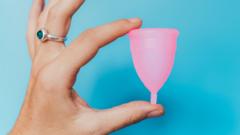Doctors are raising awareness about the potential health risks associated with menstrual cups, particularly when they are misaligned or improperly fitted. A case involving a woman in her 30s, who developed temporary kidney problems linked to her menstrual cup, has prompted this cautionary advice. The patient reported experiencing intermittent pelvic pain and blood in her urine for several months, yet she had not connected these symptoms to her menstrual cup, which serves as a reusable method for collecting menstrual blood.
Although incidents of adverse effects are exceedingly rare, misplacement of the cup can put pressure on the ureters—tubes that transport urine to the bladder—leading to serious health issues. Doctors emphasized the importance of selecting the correct size cup and ensuring proper insertion to avert potential negative impacts on the upper urinary tract.
Menstrual cups, typically made from soft silicone or rubber, offer an eco-friendly alternative to traditional sanitary products. Once inserted correctly, they can hold between 20 to 30 ml of fluid and can be worn for several hours before needing to be emptied and cleaned. The variability in cup sizes is significant, catering to different anatomical needs. For instance, smaller cups are designed for younger users or individuals who have not given birth.
First-time users may encounter challenges, particularly when it comes to removing the cup. Surveys indicate that many experience difficulty during their initial attempts, some even requiring assistance. Experts recommend a careful approach to removal—merely pulling on the cup's stem could lead to complications. Instead, it is advised to squeeze the base of the cup to release the suction seal.
Physiotherapist Dr. Kate Lough emphasizes that menstrual cups are generally safe when used correctly. "When it's in correctly, you shouldn't feel it," she states, underlining the importance of allowing individuals time to adapt to using them. Furthermore, shoppers are encouraged to explore various cup shapes, sizes, and firmness levels to find the best fit for their bodies.
In regards to additional tools, menstrual discs provide a similar function but are positioned higher in the vaginal canal, just below the cervix. The potential for complications also exists with contraceptive coils, which could be dislodged by menstrual cups; hence, users are advised to seek professional medical advice if they suspect a mishap.
As such, detailed educational material is deemed crucial in guiding users to make informed decisions about menstrual cup use to enhance safety and comfort in managing their menstrual health.






















